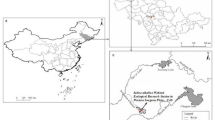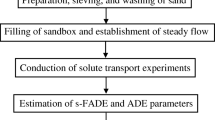Abstract
Purpose
Assessing solute transport in porous media is important for better understanding groundwater contamination. Transport parameters are closely related to the soil geometry, which exhibits self-similarity both in particle size distribution and pore characteristics, which can be modeled mathematically with fractals. Therefore, studying the relation between soil fractal characteristics and solute transport parameters is crucial.
Materials and methods
In this study, hydrodynamic dispersion experiments were carried out in six sandy soil columns that represent different porous aquifers to calculate the solute transport parameters including the hydraulic conductivity (Ks) and dispersion coefficient (DL). The mass fractal dimension (Dm) was calculated on the basis of measuring the particle size distribution of the six soil samples, and the pore volume fractal dimension (Dv) of the soil was calculated by analyzing scanning electron microscope images of the soil with the software Pores (Particles) and Cracks Analysis System (PCAS). The relationships among Dm, Dv, and the solute transport characteristics (saturated permeability and hydrodynamic dispersion) in the sandy soil were analyzed.
Results and discussion
The results suggested three mass fractal scaling domains for the studied soils: 1~10 μm (I), 10~60 μm (II), and 60~420 μm (III). Better soil gradation resulted in a larger Dm in scaling domains I and III and a smaller Dm in domain II. Dv decreased slightly with the coefficient of uniformity (Cv). Better soil gradation resulted in a larger DL and a smaller Ks. Ks decreased with increasing Dm, and DL increased slightly with increasing Dm in the whole scaling domain. The Dm results in the divided scaling domains had little significance for the evaluation of DL and Ks. Ks decreased with increasing Dv, and DL increased with increasing Dv for the studied soils.
Conclusions
In short, the studied soils showed three typical mass fractal scaling domains, and the Dm varied differently among the three scaling domains. A better soil gradation and more fine soil particles led to a higher Dm. Dv decreased with Cv. Better soil gradation resulted in a larger DL and a smaller Ks. The influence of Dv on Ks and DL is greater than that of Dm on Ks and DL. The use of one or more comprehensive indicators should be promoted, and other fractal characteristics of soils, not only the fractal mass, should be considered. More attention should be paid to the pore volume properties to more accurately characterize solute transport in soil.












Similar content being viewed by others
References
Adler PM (1996) Transports in fractal porous media. J Hydrol 187:195–213. https://doi.org/10.1016/S0022-1694(96)03096-X
Adler PM, Thovert JF (1993) Fractal porous media. Transp Porous Media 13:41–78. https://doi.org/10.1007/BF00613270
Alfaro Soto MA, Chang HK, van Genuchten MT (2017) Fractal-based models for the unsaturated soil hydraulic functions. Geoderma 306:144–151. https://doi.org/10.1016/j.geoderma.2017.07.019
Baer JU, Kent TF, Anderson SH (2009) Image analysis and fractal geometry to characterize soil desiccation cracks. Geoderma 154:153–163. https://doi.org/10.1016/j.geoderma.2009.10.008
Bittelli M, Campbell GS, Flury M (1999) Characterization of particle-size distribution in soils with a fragmentation model. Soil Sci Soc Am J 63:782–788
Clapp RB, Hornberger GM (1978) Empirical equations for some soil hydraulic properties. Water Resour Res 14:601–604
Crawford JW, Ritz K, Young IM (1993) Quantification of fungal morphology, gaseous transport and microbial dynamics in soil: an integrated framework utilising fractal geometry. Geoclerma 56:157–172
Cui H, Wang Y, Zhang M, Wang W, Zhao C (2018) A fractal method to calculate the permeability for compressible gas flow through a porous restrictor in aerostatic bearings. Int J Heat Mass Transf 121:437–452. https://doi.org/10.1016/j.ijheatmasstransfer.2018.01.012
Ersahin S, Gunal H, Kutlu T, Yetgin B, Coban S (2006) Estimating specific surface area and cation exchange capacity in soils using fractal dimension of particle-size distribution. Geoderma 136:588–597. https://doi.org/10.1016/j.geoderma.2006.04.014
Gao H, Yu B, Duan Y, Fang Q (2014) Fractal analysis of dimensionless capillary pressure function. Int J Heat Mass Transf 69:26–33. https://doi.org/10.1016/j.ijheatmasstransfer.2013.10.006
Ghanbarian B, Daigle H (2015) Fractal dimension of soil fragment mass-size distribution: a critical analysis. Geoderma 245–246:98–103. https://doi.org/10.1016/j.geoderma.2015.02.001
Ghanbarian-Alavijeh B, Millán H (2009) The relationship between surface fractal dimension and soil water content at permanent wilting point. Geoderma 151:224–232. https://doi.org/10.1016/j.geoderma.2009.04.014
Giménez, D., Allmaras, R.R., Huggins, D.R. and Nater, E. A. (1994) Fractal characterization of tilled layers to predict saturated hydraulic conductivity. Proc. 13th International Conference, International Soil Tillage Research Organization, 24–29 July 1994, Aalborg, Denmark, pp 555–560
Giménez D, Perfect E, Rawls WJ, Pachepsky Y (1997) Fractal models for predicting soil hydraulic properties: a review. Eng Geol 48:161–183
Grout H, Tarquis AM, Wiesner MR (1998) Multifractal analysis of particle size distributions in soil. Environ Sci Technol 32:1176–1182. https://doi.org/10.1021/es9704343
Hatano R, Booltink HWG (1992) Using fractal dimensions of stained flow patterns in a clay soil to predict bypass flow. J Hydrol 135:121–131
Hatano R, Kawamura N, Ikeda J, Sakuma T (1992) Evaluation of the effect of morphological features of flow paths on solute transport by using fractal dimensions of methylene blue staining pattern. Geoderma 53:31–44
Huang G, Zhang R (2005) Evaluation of soil water retention curve with the pore-solid fractal model. Geoderma 127:52–61. https://doi.org/10.1016/j.geoderma.2004.11.016
Huang GH, Zhang RD, Huang QZ (2006) Modeling soil water retention curve with a fractal method. Pedosphere 16:137–146. https://doi.org/10.1016/S1002-0160(06)60036-2
Hunt AG (2004) Percolative transport in fractal porous media. Chaos, Solitons and Fractals 19:309–325. https://doi.org/10.1016/S0960-0779(03)00044-4
Ibáñez JJ, Pérez-Gómez R, San José Martínez F (2009) The spatial distribution of soils across Europe: a fractal approach. Ecol Complex 6:294–301. https://doi.org/10.1016/j.ecocom.2009.05.008
Li K (2010) More general capillary pressure and relative permeability models from fractal geometry. J Contam Hydrol 111:13–24. https://doi.org/10.1016/j.jconhyd.2009.10.005
Li GM, Chen CX (1995) Fractal geometry and estimation of scale-dependent dispersivity in geologic media (in Chinese). Earth Science-Journal of China University of Geosciences 4(20):405–409
Li Z, Zhou Z, Dai Y, Huang Y, Guo Q, Zhou C (2017) Contaminant transport in a small deformation aquitard affected by the delayed drainage phenomenon. Hydrol Process 31(24):4429–4439
Li W, Zhao H, Li S, Sun W, Wang L, Li B (2018) A fractal model of effective stress of porous media and the analysis of influence factors. Results Phys 8:920–925. https://doi.org/10.1016/j.rinp.2017.12.042
Li Z, Zhou Z, Dai Y, Dai B (2019) Contaminant transport in a largely-deformed aquitard affected by delayed drainage. J Contam Hydrol 221:118–126. https://doi.org/10.1016/j.jconhyd.2019.02.002
Liu C, Shi B, Zhou J, Tang C (2011) Quantification and characterization of microporosity by image processing, geometric measurement and statistical methods: application on SEM images of clay materials. Appl Clay Sci 54:97–106. https://doi.org/10.1016/j.clay.2011.07.022
Liu R, Yu L, Jiang Y, Wang Y, Li B (2017) Recent developments on relationships between the equivalent permeability and fractal dimension of two-dimensional rock fracture networks. J Nat Gas Sci Eng 45:771–785. https://doi.org/10.1016/j.jngse.2017.06.013
Miao T, Long Z, Chen A, Yu B (2017) Analysis of permeabilities for slug flow in fractal porous media. Int Commun Heat Mass Transf 88:194–202. https://doi.org/10.1016/j.icheatmasstransfer.2017.09.002
Millán H, González-Posada M (2005) Modelling soil water retention scaling. Comparison of a classical fractal model with a piecewise approach. Geoderma 125:25–38. https://doi.org/10.1016/j.geoderma.2004.06.003
Mohammadi M, Shabanpour M, Mohammadi MH, Davatgar N (2019) Characterizing spatial variability of soil textural fractions and fractal parameters derived from particle size distributions. Pedosphere 29:224–234. https://doi.org/10.1016/S1002-0160(17)60425-9
Muller J (1996) Characterization of pore space in chalk by multifractal analysis. J Hydrol 187:215–222. https://doi.org/10.1016/S0022-1694(96)03097-1
Pachepsky Y, Timlin D (1998) Water transport in soils as in fractal media. J Hydrol 204:98–107. https://doi.org/10.1016/S0022-1694(97)00110-8
Peng G, Xiang N, Lv S, Zhang G (2014) Fractal characterization of soil particle-size distribution under different land-use patterns in the Yellow River Delta wetland in China. J Soils Sediments 6(14):1116–1122
Perfect E (1997) Fractal models for the fragmentation of rocks and soils: a review. Eng Geol 48:185–198
Perfect E, Kay BD (1995) Brittle fracture of fractal cubic aggregates. Soil Sci Soc Am J 59:969–974
Posadas AND, Giménez D, Bittelli M, Vaz CMP, Flury M (2001) Multifractal characterization of soil particle-size distributions. Soil Sci Soc Am J 65:1361–1367
Posadas AND, Giménez D, Quiroz R, Protz R (2003) Multifractal characterization of soil pore systems. Soil Sci Soc Am J 67:1361–1369. https://doi.org/10.2136/sssaj2003.1361
Salako FK, Babalola O, Hauser S, Kang BT (1999) Soil macroaggregate stability under different fallow management systems and cropping intensities in southwestern Nigeria. J Geod 91(1):103–123
San José Martínez F, Caniego FJ, García-Gutiérrez C (2017) Lacunarity of soil macropore space arrangement of CT images: effect of soil management and depth. Geoderma 287:80–89. https://doi.org/10.1016/j.geoderma.2016.09.007
Shen X, Li L, Cui W, Feng Y (2018) Improvement of fractal model for porosity and permeability in porous materials. Int J Heat Mass Transf 121:1307–1315. https://doi.org/10.1016/j.ijheatmasstransfer.2018.01.084
Soto-Gómez D, Pérez-Rodríguez P, Vázquez-Juiz L, López-Periago JE, Paradelo M (2018) Linking pore network characteristics extracted from CT images to the transport of solute and colloid tracers in soils under different tillage managements. Soil Tillage Res 177:145–154. https://doi.org/10.1016/j.still.2017.12.007
Tyler SW, Wheatcraf SW (1992) Fractal scaling of soil particle-size distributions: analysis and limitations. Soil Sci Soc Am J 2(56):362–369
Tyler SW, Wheatcraft SW (1990) Fractal processes in soil water retention. Water Resource Research 5(26):1047–1054
Wang S, Wu T, Qi H, Zheng Q, Zheng Q (2015) A permeability model for power-law fluids in fractal porous media composed of arbitrary cross-section capillaries (in Chinese). Phys A Stat Mech its Appl 437:12–20. https://doi.org/10.1016/j.physa.2015.05.089
Wang J, Lu X, Feng Y, Yang R (2018) Integrating multi-fractal theory and geo-statistics method to characterize the spatial variability of particle size distribution of minesoils. Geoderma 317:39–46. https://doi.org/10.1016/j.geoderma.2017.12.027
Wheatcraft, SW., Sharp, G.A. and Tyler, SW., (1991) Fluid flow and solute transport in fractal heterogeneous porous media. In: J. Bear and M.Y. Corapcioglu (Editors), Transport Processes in Porous Media. NATO ASI Series E, Vol. 202, Kluwer, Dordrecht, pp, 695–722
Wu Q, Borkovec M, Sticher H (1993) On particle-size distribution in soils. J Soil Sci Soc Am 57:883–890
Xiao L, Xue S, Liu G Bin, Zhang C (2014) Fractal features of soil profiles under different land use patterns on the Loess Plateau, China. J Arid Land 6:550–560. https://doi.org/10.1007/s40333-014-0023-7
Xu Y (2004) Calculation of unsaturated hydraulic conductivity using a fractal model for the pore-size distribution. Comput Geotech 31:549–557. https://doi.org/10.1016/j.compgeo.2004.07.003
Yanagawa F, Onuki Y, Morishita M, Takayama K (2006) Involvement of fractal geometry on solute permeation through porous poly (2-hydroxyethyl methacrylate) membranes. J Control Release 110:395–399. https://doi.org/10.1016/j.jconrel.2005.10.015
Zhu J, Cheng Y (2018) Effective permeability of fractal fracture rocks: significance of turbulent flow and fractal scaling. Int J Heat Mass Transf 116:549–556. https://doi.org/10.1016/j.ijheatmasstransfer.2017.09.026
Zuo R, Wang J (2016) Fractal/multifractal modeling of geochemical data: a review. J Geochemical Explor 164:33–41. https://doi.org/10.1016/j.gexplo.2015.04.010
Funding
This study was financed in part by the National Natural Science Foundation of China (41702259, 41702253) and the Natural Science Foundation of Department of Education of Sichuan (17ZA0041).
Author information
Authors and Affiliations
Corresponding author
Additional information
Responsible editor: Lu Zhang
Publisher’s note
Springer Nature remains neutral with regard to jurisdictional claims in published maps and institutional affiliations.
Rights and permissions
About this article
Cite this article
Li, Z., Wang, Z. Experimental study on the relation between the fractal characteristics and solute transport parameters of sandy soil. J Soils Sediments 20, 3181–3191 (2020). https://doi.org/10.1007/s11368-020-02658-4
Received:
Accepted:
Published:
Issue Date:
DOI: https://doi.org/10.1007/s11368-020-02658-4




